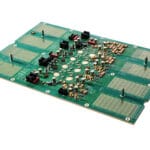
What is DIP means in the PCB Assembly industry?
In microelectronics, DIP is short for the dual in-line package, sometimes called a DIL package, which is an electronic device package with a rectangular housing and two parallel rows of electrical connecting pins. The pins are all parallel, point downward, and extend past the bottom plane of the package at least enough to be through-hole mounted to a printed circuit board (PCB), i.e. to pass through holes on the PCB and be soldered on the other side. DIP is also sometimes considered to stand for the dual in-line pin, in which case the phrase “DIP package” is non-redundant.
DIP refers to the device packaged in the form of a plug-in, and the number of pins generally does not exceed 100. Often referred to as “dip welding” or “dip post welding”, refers to the soldering of dip packaged devices after SMT.
Is DIP the same as SMT?
Not exactly, SMT is the abbreviation of surface mount technology, which is the most popular technology and process in the electronic assembly industry. It is a kind of circuit assembly technology that which the surface assembly components are installed on the surface of the circuit board or other substrates, and are welded and assembled by reflow soldering or immersion soldering.
What is the difference between SMT and DIP?
SMT is usually mounted on the surface of components without pins or short leads. It needs to print solder paste on the circuit board first, then mount it through the mounter, and then fix the device by reflow soldering. Dip welding is a kind of in-line package device, which is fixed by wave soldering or manual welding.
Both SMT and dip are part of PCBA processing, but not all PCBA factories have the ability to post welding SMT and dip, and the processing quality is also uneven. When choosing a PCBA factory for cooperation, it is recommended to go to the factory for the on-the-spot investigation to see the personnel technology, processing equipment, and the overall environment of the PCB factory.
PCB Assembly requires knowledge beyond just PCB components and assembly; it also requires expertise in printed circuit board design, layout, PCB fabrication, and applications of the final product. Auspi is a one-stop solution for all circuit board production services – fabrication, testing/inspections, and assembly. Our clients hire us to be their full or partial turn-key provider from manufacturing to assembly and testing. Through our strong network of well-proven partners, we can provide the most advanced and nearly limitless capabilities for your prototype or production PCB run.







